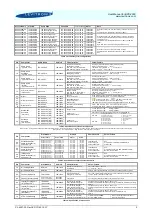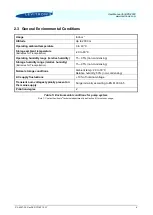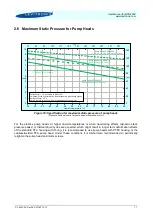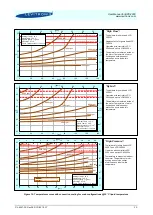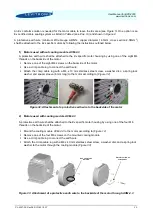
User Manual for BPS-2000
www.levitronix.com
PL-4021-00, Rev06, DCO# 21-037
19
3.4 Thermal Management
3.4.1 Motor Temperature
The motor temperature depends on the ambient and liquid temperature, as well as on the hydraulic
operation point and the characteristics (viscosity and density) of the liquid.
temperature characteristics for aqueous liquids at room temperature.
For higher liquid temperatures and hydraulic operating points active cooling is recommended for example
with the
Air Cooling Module
ACM-4.2
), the
Fan Cooling Module FCM-2000.1
or with the motor with integrated water cooling (see
Figure 19, Figure 20, Figure 21 and Figure 22
are values of the motor temperature at certain
liquid and ambient temperatures. For other liquid and ambient temperatures the equation
with the
parameters in
can be used as an approximation to calculate the motor temperature.
𝑇
𝑀
(
𝑇
𝐿
𝑇
𝐴
) ≈ 𝑇
𝑀
(𝑇
𝐿
= 25°𝐶, 𝑇
𝐴
= 25°𝐶)
⏟
𝐶𝑜𝑛𝑣𝑒𝑐𝑡𝑖𝑜𝑛 𝐶𝑜𝑜𝑙𝑖𝑛𝑔: 𝑠𝑒𝑒 𝐹𝑖𝑔𝑢𝑟𝑒 19
+ (𝑇
𝐿
− 25°𝐶) ∙
𝑡𝑔
𝐿𝑀
⏟
𝑠𝑒𝑒 𝑇𝑎𝑏𝑙𝑒 11
+ (𝑇
𝐴
− 25°𝐶)
𝑇
𝑀
(
𝑇
𝐿
𝑇
𝐴
) ≈ 𝑇
𝑀
(𝑇
𝐿
= 70°𝐶, 𝑇
𝐴
= 25°𝐶)
⏟
𝐶𝑜𝑜𝑙𝑖𝑛𝑔 𝐴𝐶𝑀−4.2: 𝑠𝑒𝑒 𝐹𝑖𝑔𝑢𝑟𝑒 20
𝐶𝑜𝑜𝑙𝑖𝑛𝑔 𝐹𝐶𝑀−2000.1: 𝑠𝑒𝑒 𝐹𝑖𝑔𝑢𝑟𝑒 21
+ (𝑇
𝐿
− 70°𝐶) ∙
𝑡𝑔
𝐿𝑀
⏟
𝑠𝑒𝑒 𝑇𝑎𝑏𝑙𝑒 11
+ (𝑇
𝐴
− 25°𝐶)
𝑇
𝑀
(
𝑇
𝐿
𝑇
𝐴
) ≈ 𝑇
𝑀
(𝑇
𝐿
= 70°𝐶, 𝑇
𝐶𝐿
= 25°𝐶)
⏟
𝑊𝑎𝑡𝑒𝑟 𝑐𝑜𝑜𝑙𝑖𝑛𝑔∶ 𝑠𝑒𝑒 𝐹𝑖𝑔𝑢𝑟𝑒 22
+ (𝑇
𝐿
− 70°𝐶) ∙
𝑡𝑔
𝐿𝑀
⏟
𝑠𝑒𝑒 𝑇𝑎𝑏𝑙𝑒 11
+ (𝑇
𝐶𝐿
− 25°𝐶)
𝑇
𝑀
=
𝑀𝑜𝑡𝑜𝑟 𝑡𝑒𝑚𝑝𝑒𝑟𝑎𝑡𝑢𝑟𝑒
𝑇
𝐴
=
𝐴𝑚𝑏𝑖𝑒𝑛𝑡 𝑡𝑒𝑚𝑝𝑒𝑟𝑎𝑡𝑢𝑟𝑒
𝑇
𝐶𝐿
=
𝑇𝑒𝑚𝑝𝑒𝑟𝑎𝑡𝑢𝑟𝑒 𝑜𝑓 𝑐𝑜𝑜𝑙𝑖𝑛𝑔 𝑙𝑖𝑞𝑢𝑖𝑑
𝑇
𝐿
=
𝐿𝑖𝑞𝑢𝑖𝑑 𝑡𝑒𝑚𝑝𝑒𝑟𝑎𝑡𝑢𝑟𝑒
𝑡𝑔
𝐿𝑀
=
𝑇𝑒𝑚𝑝𝑒𝑟𝑎𝑡𝑢𝑟𝑒 𝑔𝑟𝑎𝑑𝑖𝑒𝑛𝑡 𝑙𝑖𝑞𝑢𝑖𝑑/𝑚𝑜𝑡𝑜𝑟
(Eq. 1)
Cooling
Method
Pump Head Type
Convection
Cooling
Air Cooling Module
ACM-4.2
Fan Cooling
Module FCM-2000.1
Motor with integrated
Water Cooling
LPP-2000.7/14/22 (plastic housing)
0.28
0.29 (with 20 Nm
3
/h)
0.32
0.09
LPP-2000.20 (stainless steel housing)
0.41
0.26 (with 20 Nm
3
/h)
0.29
NA
Table 11: Temperature gradients liquid/motor
All presented thermal data are typical values, which are partly based on measurements and partly on
interpolations with a simplified thermal model and are therefore only guideline values and are suitable for a
first layout of the basic thermal concept. It is recommended to check the thermal values with the motor
placed on the final location and under worst case performance conditions of the application.
In order to account for thermal variations (like ambient temperature, closed chemical cabinets or corners
without ventilations) and to not significantly reduce the MTBF of the motor it is recommended to keep about
20
°C
safety distance to the absolute thermal limit of the motor (90
°C
) when designing and testing the
thermal concept of the pump system.

